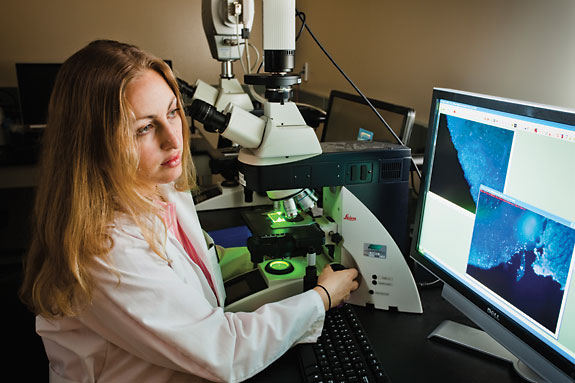The Monje Lab | Scope and Accomplishments
The Monje Lab studies the developmental origins and unique biology of pediatric gliomas, especially DIPG.
Childhood brain development and pediatric gliomas
The myelinated infrastructure of the brain develops throughout childhood and adolescence, and discrete waves of developmental myelination correlate with the age and location of pediatric glioma formation. As mounting evidence from the Monje Lab and from others indicates that pediatric gliomas like DIPG arise from myelin-forming precursor cells, understanding the mechanisms that govern the growth and differentiation of these cells becomes paramount to discerning what drives pediatric glioma initiation and growth. Recent work from the lab has demonstrated that neuronal activity robustly promotes the proliferation and differentiation of normal myelin forming precursor cells, ultimately modulating the white matter structure of active circuits in a manner that facilities neural circuit function of those brain networks most used by that individual. These results give clues to a possible powerful driver of growth in the glioma microenvironment, clues the lab is actively following up now. Moreover, these findings shed light on a previously under-recognized mechanism by which experience modulates brain structure and function, with implications not only for brain cancer but also for neuroregeneration in diseases of white matter such as multiple sclerosis.
Therapeutic targets in DIPG
The Monje lab has been developing, distributing and utilizing unique patient-derived DIPG cell culture and orthotopic xenograft mouse models in an effort of discover effective therapies for DIPG. As part of an international collaborative effort to screen DIPG cell lines for response to new and emerging targeted chemotherapy agents, we have identified a promising therapeutic candidate and have successfully negotiated access to this drug for a Phase I clinical trial for newly diagnosed and recurrent DIPG, anticipated to open in 2014-2015. We continue to study the unique molecular biology of DIPG, its cellular hetereogeneity and its interactions with the microenvironment of the childhood brain to identify additional effective therapeutic strategies.
Long-term consequences of childhood cancer therapy on the developing brain
Children who survive childhood cancer therapy frequently experience life-long and progressive deficits in cognitive function. Damage to neural precursor cell populations responsible for brain development, maintenance and plasticity, including myelin-forming precursor cells, is thought to underlie much of the cognitive dysfunction that follows cancer therapy. The Monje Lab studies the mechanisms responsible for this precursor cell dysfunction and seeks to harness and regulate mechanisms of myelin plasticity in neuroregenerative strategies aimed at improving cognition after cancer therapy.
For more information, please visit the Monje Lab website



